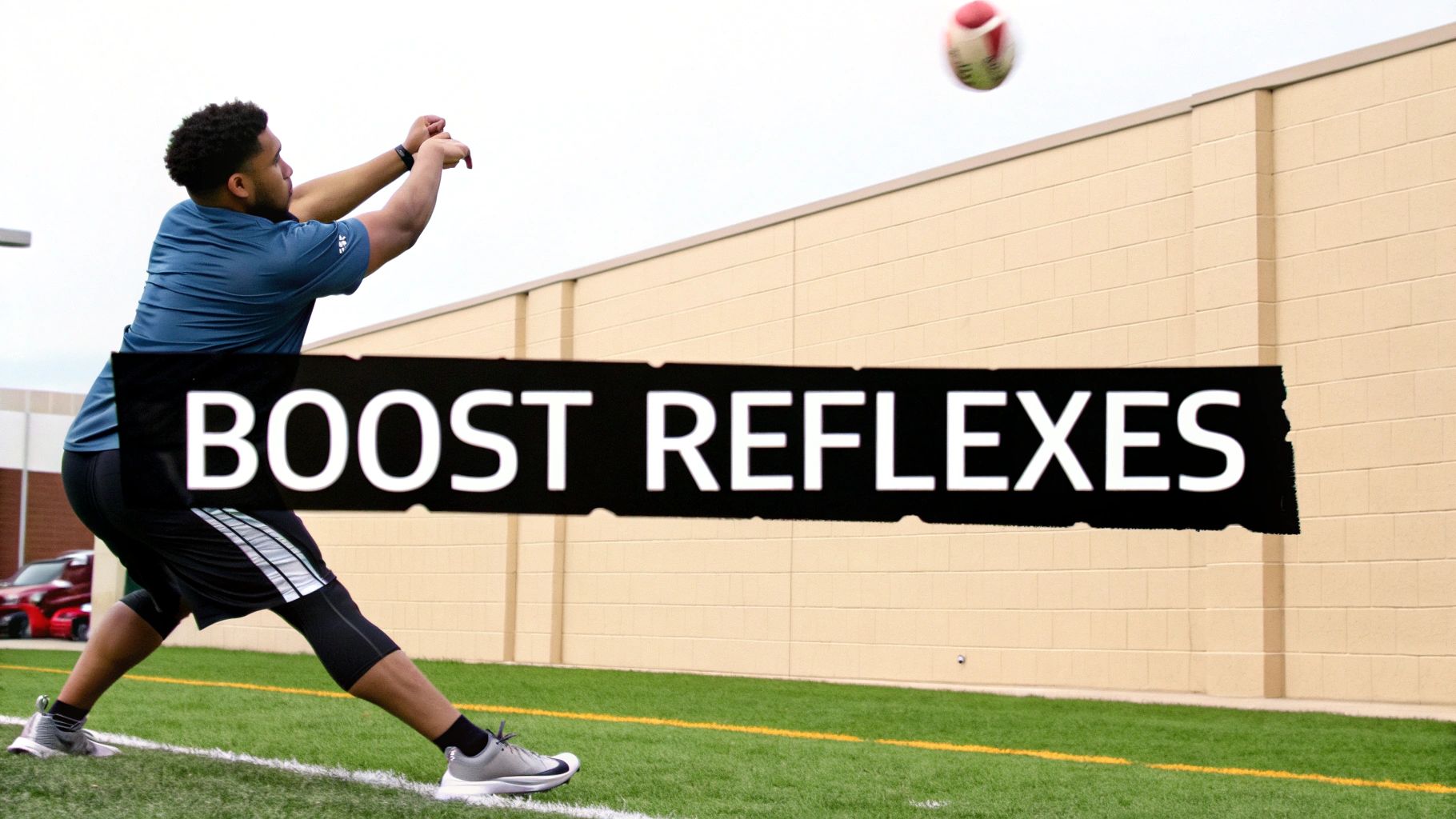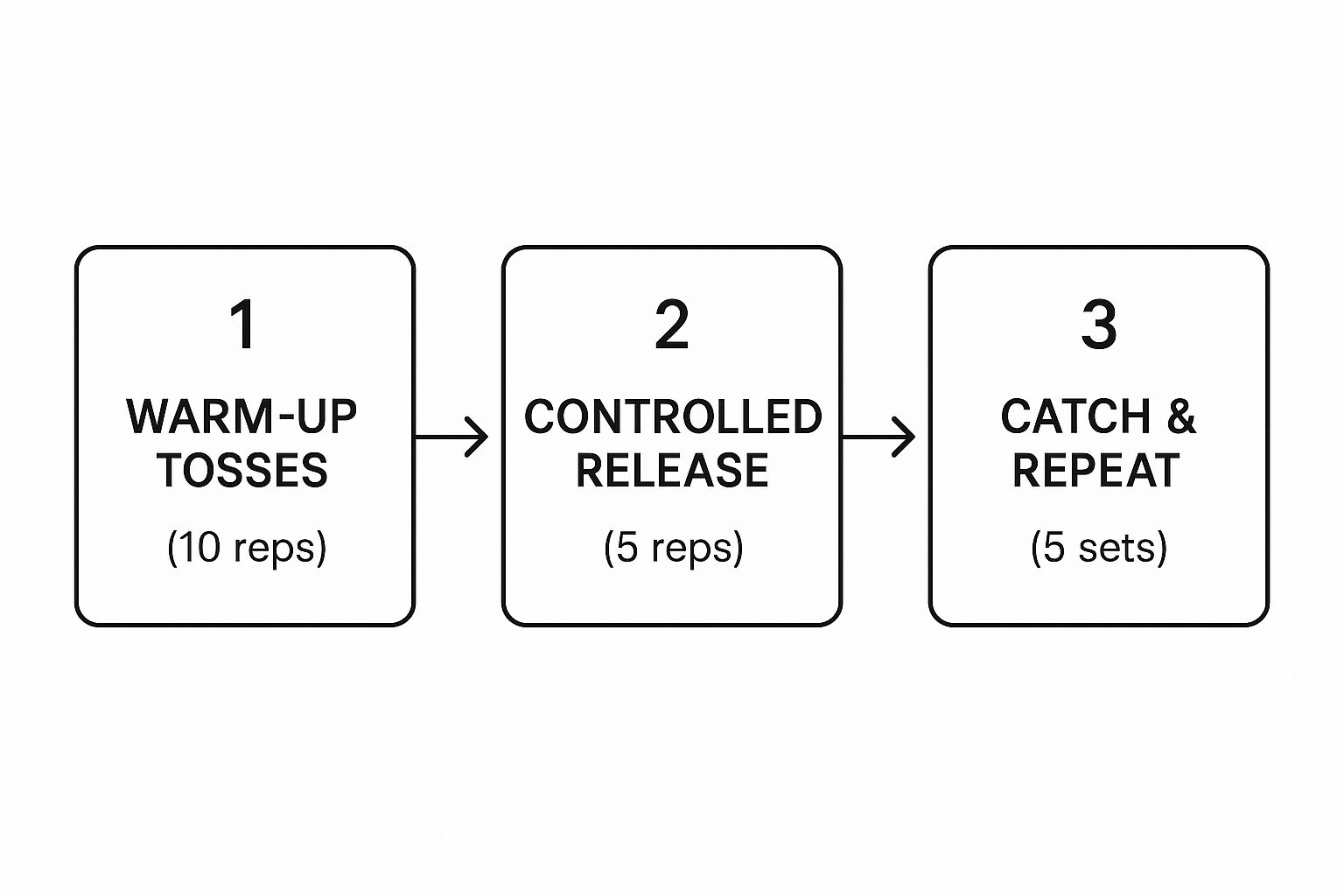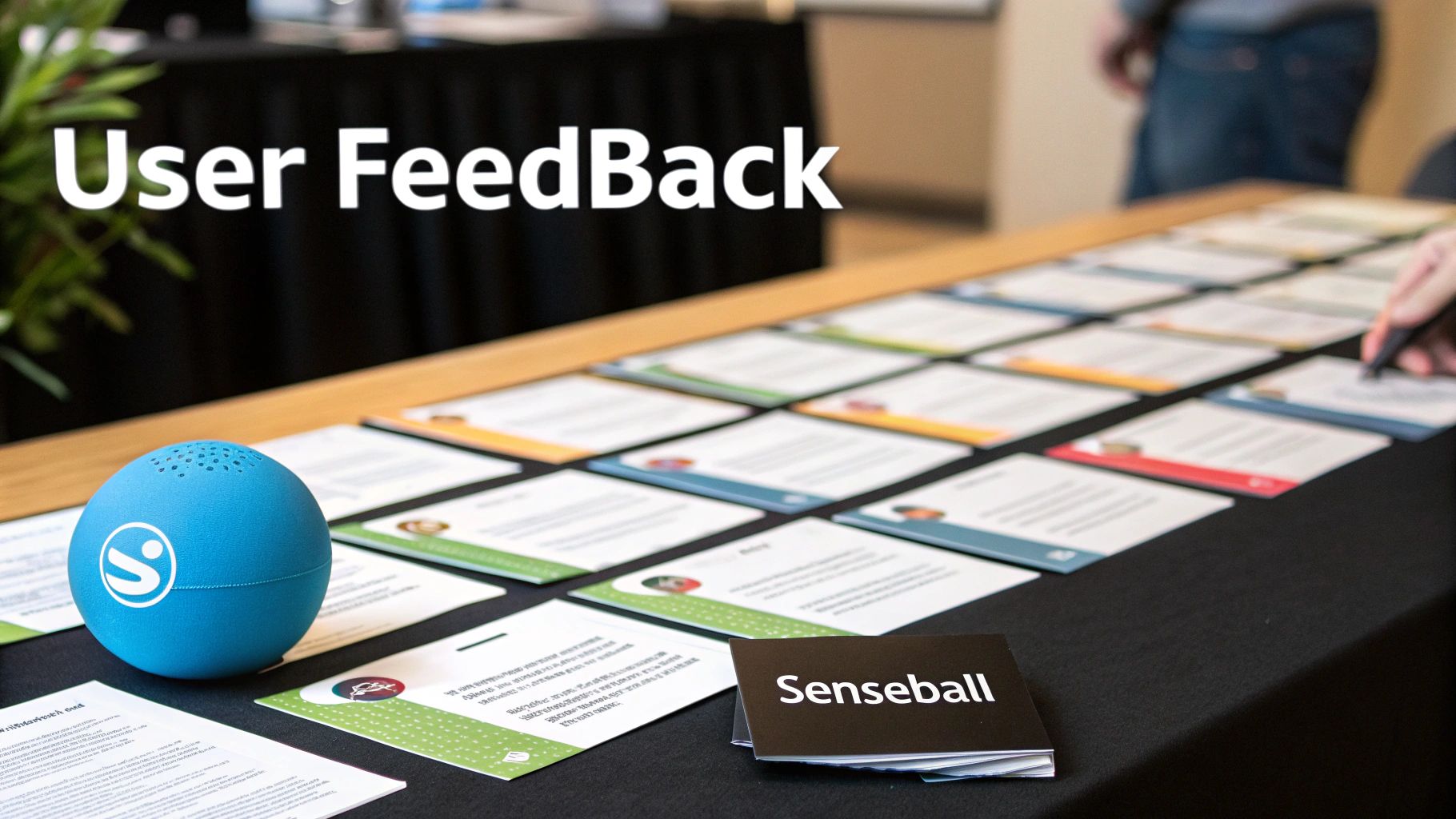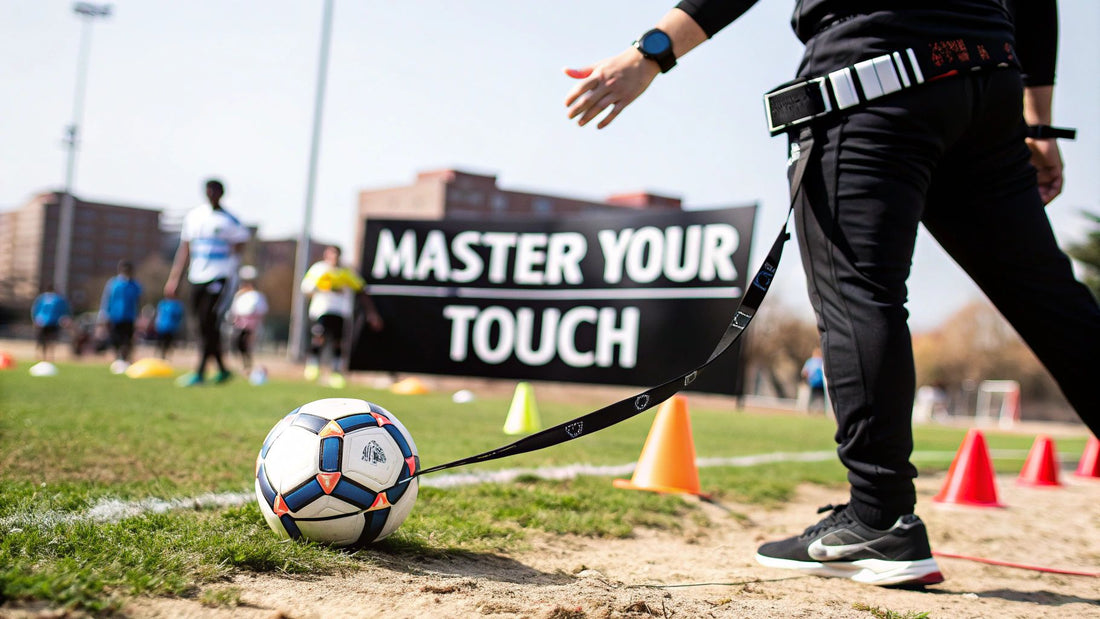A SenseBall is a specialised piece of football training equipment designed to sharpen a player's touch, rhythm, and two-footed ability through thousands of rapid repetitions. It’s a simple concept: a size 2 football is attached by an adjustable elasticated cord to a waist belt. This setup allows you to get thousands of touches in a very short space of time, maximising your practice efficiency.
This guide will break down exactly how it works, provide a detailed review, outline key drills you can use, and ultimately, help you decide whether it's the right tool for you or your young footballer.
What Is a SenseBall and How Does It Work?
At its heart, the SenseBall is a deceptively simple device built on the principle of neuromuscular training. By tethering the ball to the player, it forces continuous engagement because the ball always returns directly to you. This completely eliminates the time you'd normally waste chasing stray balls, massively increasing your contact time.
This constant repetition is what makes it so effective for developing muscle memory.
The system is engineered to help players perfect their footballing rhythm and become genuinely two-footed. When you kick the ball, it swings back, demanding an immediate touch with the opposite foot to maintain a steady cadence. It's this constant back-and-forth that starts to ingrain ambidexterity into a player’s natural movement.
The Science Behind the String
The real magic of the SenseBall is how it accelerates skill acquisition through sheer volume. You can accumulate hundreds of touches in just a few minutes—an amount simply not possible in a typical training session.
This high volume of practice helps to:
- Refine Ball Control: Constant contact with different parts of both feet sharpens your first touch and close control.
- Improve Coordination and Balance: The need to adjust your body position for every returning touch enhances your overall motor skills and stability.
- Boost Concentration: Keeping a consistent rhythm demands real focus, training a player's mind just as much as their body.
The SenseBall isn't just a ball on a string; it's a feedback loop. Every touch informs the next, creating a rapid learning cycle that quickly builds a player's feel for the ball and spatial awareness.
A Growing Trend in UK Football Training
Tools like the SenseBall are becoming increasingly popular in the UK, where grassroots and academy coaching places a huge emphasis on technical skill. This trend is reflected in market data, with the UK's sports technology market projected to grow significantly, driven by innovations that offer players and coaches measurable feedback.
Case studies from UK football academies show that consistent SenseBall use can improve ball control accuracy by 20%-30% after just a six-week programme. It's clear evidence that this simple tool delivers a real, practical impact on a player's game.
Of course, the SenseBall is just one part of a modern player's toolkit. For a broader look at what can help elevate your game, have a look at our guide on essential football training equipment.
My Honest SenseBall Review: Putting It to the Test

So, does the SenseBall actually live up to the hype? I spent several weeks with it, moving beyond the marketing claims to see how it really performs. From quick sessions in the garden to more structured drills, I wanted to get a proper feel for what it can do.
Getting started is incredibly straightforward. You pop the belt around your waist, adjust the cord so the ball dangles just above your ankles, and you're ready to go. But let's be honest—those first few minutes are a real leveller. My initial attempts were a clumsy mess of tangled strings and kicks that went nowhere.
That initial awkwardness is a crucial part of the learning curve. It forces you to abandon bad habits and focus intently on finding a rhythm. After about 15 minutes or so, something clicks. The ball comes back to you every single time, so you can stop chasing and concentrate purely on your touch and timing. This is where the magic really begins.
Durability and Build Quality
A training tool is useless if it falls apart after a week. I had my doubts, but after weeks of daily use—I'm talking countless scuffs, hard kicks, and being dragged across the patio—the ball and cord have held up brilliantly.
The size 2 ball is tough, with solid stitching. More importantly, the elasticated cord still has all its tension, with no signs of fraying. It's clear this product was built to withstand thousands of repetitions, which is a massive plus.
Does It Genuinely Improve Your Skills?
This is the million-dollar question. From my experience, the answer is a resounding yes, particularly in a few key areas.
- First Touch: My ability to cushion the ball has improved out of sight. The sheer repetition drills a softer, more controlled contact into your muscle memory simply to keep the rhythm going.
- Two-Footed Play: The SenseBall is relentless. It forces you to use both feet, over and over again. This constant switching quickly builds confidence and coordination in your weaker foot until it starts to feel natural.
- Close Control: Using the SenseBall feels like training inside a phone box. You have no choice but to learn how to manipulate the ball in tight spaces, which pays off significantly when you're under pressure from a defender in a real match.
The real 'aha!' moment comes when you stop thinking about the mechanics and just fall into a steady rhythm. That's when you realise your touch has become instinctive—a perfect example of what focused muscle memory training can achieve.
The SenseBall isn't a magic wand that will turn you into Messi overnight. However, it is an incredibly effective tool for building the foundational skills every player needs. It won’t replace team practice, but it's an exceptionally efficient way to get thousands of quality touches that will sharpen your control and coordination.
If you're serious about taking your fundamental skills to the next level, the SenseBall is a brilliant addition to your training gear. It offers a unique way to fast-track your development that's tough to replicate with other methods.
Fundamental SenseBall Drills to Build Your Base
Right, you understand what the SenseBall is all about, so let's get down to business. It's time to start building your technical foundation, and that begins with the absolute basics. Before you even think about fancy manoeuvres, you need to master the fundamental drills. The goal here isn’t speed—it's about rhythm and achieving a clean, consistent touch on the ball.
Think of these initial exercises as learning the alphabet of ball control. Every correct touch builds the muscle memory needed for the fluid, instinctive movements you see in professional players. We’re going to focus on a few core drills that every player has to nail down.
Alternating Inside-Foot Taps
This is the quintessential SenseBall drill and the absolute first thing you should do. The aim is simple: create a steady, pendulum-like swing with the ball, using the inside of both your feet.
Get into a good stance—feet shoulder-width apart, knees slightly bent. Gently tap the ball with the inside of your dominant foot so it swings across your body. As it returns, meet it with the inside of your weaker foot to send it swinging the other way.
A few key things to focus on:
- Stay balanced. Be light on your toes, always ready to shift your weight. Do not stand flat-footed.
- Make it a soft, clean contact. You are not trying to hoof it. All you need is a gentle, controlled tap to keep the rhythm going.
- Find that steady cadence. You should hear a consistent "tap... tap... tap..." sound. That rhythm is exactly what you're trying to ingrain.
Controlled Sole Rolls
Once you're comfortable with the inside-foot taps and have a nice rhythm going, it's time for the sole roll. This drill is brilliant for developing a feel for the ball and is a crucial skill for dribbling in tight spaces.
Start the same pendulum motion as before. This time, however, as the ball swings back, stop it by gently placing the sole of your foot on top. Then, roll the ball across your body towards your other foot and repeat the process. You're essentially stopping and restarting the rhythm with every single touch. This simple infographic breaks down the initial warm-up sequence to get you started.

This drill forces you to control the ball's momentum before you make your next move—a skill that's absolutely vital in a real game when you're under pressure.
To help you structure your first couple of weeks, I've put together a simple progression plan. Don't rush it; consistency is far more important than intensity at this stage.
Beginner SenseBall Drill Progression
| Week | Drill Focus | Daily Session Time | Key Objective |
|---|---|---|---|
| Week 1 | Alternating Inside-Foot Taps (Dominant & Weak Foot) | 10-15 minutes | Establish a consistent, steady rhythm. Focus on clean contact and balance. |
| Week 2 | Inside-Foot Taps + Controlled Sole Rolls | 15-20 minutes | Integrate sole rolls to control momentum. Aim for a smooth transition between tapping and rolling. |
Stick to this simple plan, and you'll be surprised at how quickly your touch and coordination improve. It's all about building a solid base before moving on.
Tips for Avoiding Common Pitfalls
Let's be honest, it’s going to be frustrating at first. You will get tangled in the string, and the ball will feel like it has a mind of its own. Do not worry. That is all part of the process.
The initial awkwardness is a sign you are breaking old habits. Stick with it, and focus on slow, deliberate movements. The speed will come naturally once the muscle memory is established.
To help you get past that initial stage faster, try to avoid these common mistakes:
- Kicking too hard. This is the #1 error. It sends the ball flying wildly and makes it impossible to find any rhythm.
- Staying flat-footed. You have to be on the balls of your feet, constantly adjusting your position to meet the ball cleanly.
- Looking down the whole time. Try to get your head up as much as possible. Use your peripheral vision to track the ball. This is a crucial habit for developing on-pitch awareness.
These basic drills are your gateway to real ball mastery. While these exercises focus on individual control, it’s also important to see how good footwork fits into team play. For anyone looking to improve their positioning, our guide on essential soccer drills for defense offers valuable insights.
Advanced Drills for Next-Level Ball Control
Once you’ve mastered the basic rhythm of the SenseBall, it’s time to elevate your training. The foundational drills are brilliant for building that initial touch and coordination, but the real magic happens when you start moving.
These next-level exercises are all about translating that stationary control into dynamic, game-realistic situations. This is how you go from just practising your touch to developing genuine on-pitch flair, making your control so automatic you can pull off skills without even thinking about it.
Dynamic Figure-of-Eights
This drill is fantastic for improving your close control while on the move. Just grab two cones (or jumpers, water bottles, anything really) and place them about two metres apart.
Start your normal alternating inside-foot taps, but instead of staying rooted to the spot, begin weaving in a figure-of-eight pattern around the cones. The challenge here is keeping the SenseBall’s rhythm going while your body is constantly turning and changing direction. You’ll naturally start taking smaller, quicker touches to navigate the turns and longer, more purposeful ones on the straight sections—exactly like dribbling through a packed midfield.
The Weaker-Foot-Only Challenge
Being genuinely two-footed is a massive advantage on the pitch. This drill is designed to fast-track that skill. Set a timer for two or three minutes and commit to only using your weaker foot.
Start with simple inside-foot taps, then try to incorporate the figure-of-eight movement once you feel more comfortable. It’s going to feel awkward and clumsy at first, and that’s the point. This intense focus isolates your non-dominant foot, rapidly building its strength, coordination, and confidence. The improvement you'll see after just a few dedicated sessions is quite remarkable.
Pro Tip: When you get tired, your technique is the first thing to go. Fight this by doing shorter, more intense sessions. Five minutes of sharp, precise touches is far more effective than fifteen minutes of simply going through the motions.
This kind of detailed training aid is becoming more common in UK football. Data shows that the sports technology market, which includes tools like SenseBall, is projected to expand significantly. This growth is fuelled by the demand for training gear that provides real, measurable improvement—a niche the SenseBall fills perfectly for players at all levels. You can learn more about the advancements in the UK sports analytics market and see how tech is shaping the next generation of players.
Shielding and Turning Drills
This final drill is all about simulating what it feels like to receive the ball with a defender breathing down your neck.
Start by standing with your side to an imaginary opponent. As the ball swings towards you, use the outside of your foot to take a touch, keeping your body between the ball and the "defender." This is the essence of shielding.
From that shielded position, practise turning away from the pressure. You could use a sole roll to drag the ball back or a sharp outside-of-the-foot touch to push it into space and accelerate away. Developing this awareness is crucial for keeping possession under pressure, a skill every player needs and a key part of what we cover in our guide to effective soccer drills for defense.
Is the SenseBall a Worthwhile Investment?

So, after all the drills and hands-on testing, we arrive at the big question: should you actually buy a SenseBall?
In my experience, the answer is a firm yes, but with a couple of important caveats. It’s an incredibly effective piece of kit for fast-tracking technical skills; there's no doubt about that.
The main benefit is undeniable: you get a massive number of touches on the ball in a very short space of time. That kind of repetition is golden for building muscle memory, sharpening coordination, and, crucially, developing a proper two-footed player. The convenience is a huge win, too. You can get a solid session in the back garden or garage, regardless of the weather.
However, the SenseBall isn’t a magic bullet that replaces all other training. Its biggest weakness is that it can get repetitive. The drills are effective because they're repetitive, but that same quality can become tedious if it’s the only thing a player does. It’s a supplement, not a substitute for proper team practice where you learn game intelligence, positioning, and how to work with others.
Who Gains the Most from a SenseBall?
The SenseBall offers value to players at different stages, but some groups will certainly get more out of it than others.
- Young Players (Ages 6-12): This is the sweet spot. For children building their footballing foundations, the SenseBall is brilliant for developing a clean first touch and becoming comfortable with both feet from day one.
- Dedicated Teens: Older players looking to sharpen their close control and quick footwork will find it invaluable. It’s perfect for off-season work or getting in those extra reps to refine technique.
- Players Recovering from Injury: It offers a low-impact way to regain a feel for the ball and rebuild coordination without the physical stress of a full-contact training session.
The SenseBall isn't just for academy prospects. Any player who is genuinely committed to improving their individual technique will see real, tangible benefits. It’s fantastic at isolating and improving one of the most fundamental parts of the game: your relationship with the ball.
The Final Verdict
So, is it worth the investment? Absolutely. The SenseBall is a powerful, durable, and highly efficient training aid that delivers on its promises. It's a perfect tool for any player serious about putting in the extra work to get a technical edge over the competition.
To get the best out of it, try to weave 15-20 minute SenseBall sessions into your weekly routine 3-4 times a week. That’s enough to build the repetition needed for real improvement without it becoming a chore.
Think of it as your personal skills coach, always ready to go when you are. For any dedicated footballer, it’s a brilliant addition to the kit bag.
Got Questions About the SenseBall? We’ve Got Answers.
Even after reading a full review and seeing the drills, it’s normal to have a few questions before you decide to purchase one. We frequently get asked the same things by players and parents, so let’s get them answered right now.
How Quickly Will I Actually See Results?
This is the big one, and the honest answer is: it all comes down to consistency. You won't magically become two-footed overnight, but you'll feel a difference much faster than you might think. Most players start noticing a sharper first touch and a better rhythm within the first two weeks of regular practice – we’re talking 15-20 minutes, 3-4 times a week.
The real game-changing improvements, like being able to control the ball with your weaker foot without thinking, usually start to show after about four to six weeks. It’s all about building that muscle memory, and the SenseBall is designed to cram thousands of repetitions into a short space of time to accelerate that process.
Is the SenseBall Just for Kids?
Absolutely not. While it's an incredible tool for young players building their technical foundations, adults and even seasoned players can get a lot out of it. For older players, it’s less about learning basics from scratch and more about refining and maintaining existing skills.
For adults, the benefits are clear:
- Keeping Your Touch Sharp: It's the perfect way to keep your first touch crisp, especially if you can’t make it to team training as often as you’d like.
- Boosting Coordination: The SenseBall helps maintain balance and quick footwork, things that can get rusty without constant practice.
- A Great Low-Impact Warm-up: It's an excellent way to activate your muscles and get a feel for the ball before a match or training session without putting stress on your joints.
What Are the Biggest Mistakes People Make?
Getting off to a good start is key to building the right habits. The most common mistake we see, by a long shot, is players kicking the ball way too hard. The SenseBall is all about rhythm and control, not power. If you smash it, the string just goes wild, and you’ll never find a steady cadence.
The goal isn't to blast the ball back and forth. It's to create a smooth, pendulum-like motion that you can maintain. Start slow, focus on soft, clean touches with the inside of your feet, and the speed will come naturally as your coordination improves.
Another classic mistake is staying flat-footed. To use the SenseBall properly, you need to be light on the balls of your feet, always ready to make tiny adjustments to meet the ball cleanly. This active stance not only helps with the drills but also translates directly to being more agile on the pitch.
Ready to fast-track your skills and finally master your touch? At SoccerWares, we believe in providing the best tools to help you reach your potential.
Discover the SenseBall and other essential training gear on SoccerWares today

